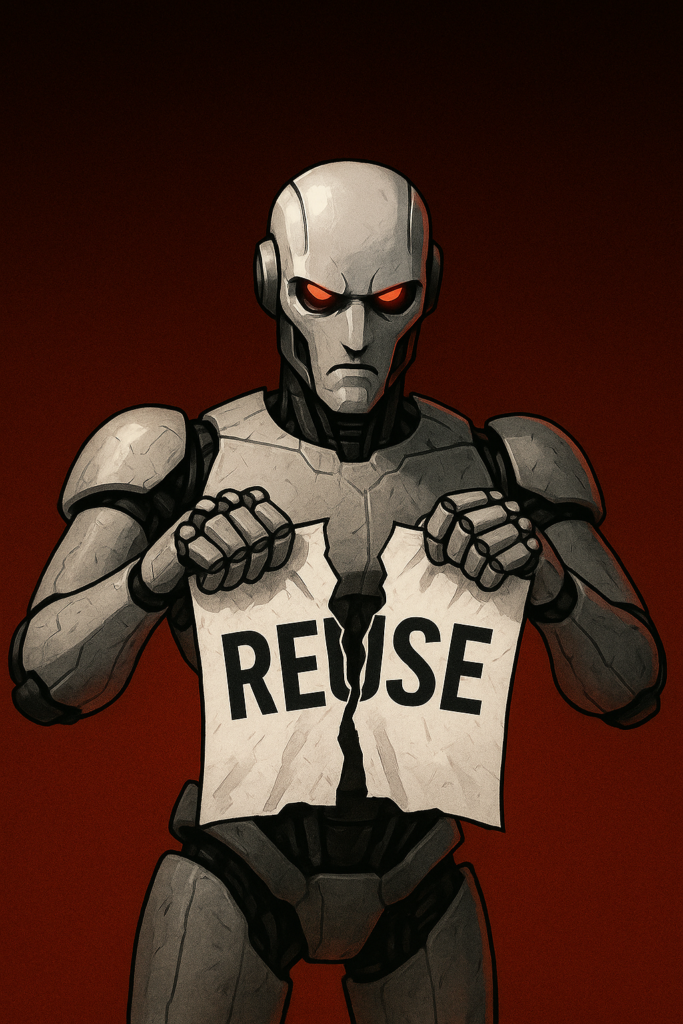
For decades, the golden rule in enterprise software was reuse, reuse, reuse. You built your data model, your workflows, and your beautiful-but-soul-sucking front-end UI, then you reused them like some kind of digital IKEA furniture set. It was efficient. It was safe. It was “good architecture.”
But here’s the ugly truth: today, reuse is becoming more expensive to maintain than to just generate new stuff on the fly and tweak it.
Let’s break down this blasphemy.
The Reuse Religion Is Breaking Under Its Own Weight
When you reuse a data model, you’re not just reusing a shape—you’re inheriting assumptions. Business logic from five years ago, naming conventions that made sense only to Bob from Finance, and the Frankensteinian XML structure duct-taped together to “future-proof” it. You’re stuck with it.
Same with workflows. That approval process your organization “standardized”? It’s different in every department because everyone hacked around it. Now you’re patching rather than building.
UI reuse is even worse. You’ve got entire front-end libraries cobbled together with components that weren’t meant to scale, aren’t responsive anymore, and definitely don’t play nice with modern accessibility guidelines or design systems. Maintaining this mess costs developer time, QA cycles, integration testing, regression testing, and existential despair.
Enter: Generative UI
This is where generative AI steps in like a caffeinated intern with zero baggage and the energy of a golden retriever.
Now, instead of manually reusing dusty old components, you describe what you want:
“I need a dashboard that tracks order fulfillment, highlights delayed shipments, and shows KPIs by region.”
And boom—Generative UI gives you a polished front end using your design system, with the right layout, accessible labels, and mock logic stubs. In minutes.
You review it, click “Finalize,” and push it to staging. No four-week sprint. No merging conflicts. No digging through a dusty Jira ticket from 2019 to figure out what “ShippingTracker_v2b_FINAL-FINAL-FINAL” was doing.
Verification Is the New Reuse
Let’s get this straight: the cost of reusing legacy components lies in integration. Making it work with modern APIs, updating styles, ensuring accessibility, regression testing… it’s a maintenance tax with compound interest.
Generative systems flip the script:
- You generate a UI, workflow, or model based on the current state of business needs and APIs.
- You verify that it works.
- You finalize it with a clean, versioned, auditable baseline.
It’s faster, cheaper, and—brace yourself—often more accurate than duct-taping the past to the present.
This Isn’t a Dream. It’s a Disruption.
Early adopters (looking at you, forward-thinking fintech and GovTech teams) are already replacing reusable libraries with prompt-based generation layered with automated testing and governance.
And guess what? They’re delivering new apps in hours, not months.
Let’s break down this disruption.
1. The Promise—and Pitfalls—of Reuse
Reuse was once hailed as a cornerstone of sound software engineering. Studies show reuse can reduce development time, improve reliability, and boost productivity. Yet, in practice, it’s fraught with hidden costs:
- Legacy baggage: Models and components carry outdated business logic, intricate naming conventions, and dated frameworks.
- Dependency entropy: Chains of dependencies create brittle systems where a single change cascades breakages arxiv.org.
- Maintenance tax: Empirical studies indicate that CI/CD pipelines and automation workflows like GitHub Actions generate substantial and increasing maintenance load medium.com+3arxiv.org+3medium.com+3.
Increasingly, the cost of adapting old components to modern APIs, design systems, and accessibility standards outweighs building anew.
2. Generative UI & Workflow: A New Paradigm
Generative AI is stepping into the breach. By describing desired functionality in natural language, engineers can instantly generate polished UI components, workflows, and mock integrations. For example:
- Companies use LLMs to automatically refactor legacy code, saving on technical debt—estimated at roughly $361K/year for just 100K medium.com.
- Enterprise-scale RPA systems are often slow to set up (~12–18 months), limited in accuracy (~60%), and require ongoing human effort. Generative agents can automate entire workflows with moderate accuracy (e.g., 93% task understanding, 40% end-to-end completion) —without those burdens arxiv.org.
3. Measuring the True Cost: Maintenance vs. Generation
3.1 Traditional Maintenance Overhead
- Infrastructure and compute for generative models range from tens to hundreds of thousands for on-prem/GPU deployments, plus recurring costs .
- Change management and integration can cost 2–3× the initial deployment, especially when integrating GenAI into workflows and governance systems .
3.2 Legacy Reuse Tax
- Maintenance costs for old components can eat 15–30% of software budgets—and often more for aging stack remnants.
- Fixing brittle workflows like GitHub actions requires regular human intervention.
3.3 Generative Approach ROI
- Speed: UI and workflow components can be generated in minutes.
- Reliability: Cleaner, context-aware baseline reduces technical debt.
- Verification-first mindset: Instead of patching odd legacy code, teams generate, validate, and finalize solutions grounded in current APIs and style guides.
Final Thought: Reuse Isn’t Dead, It’s Just… Optional Now
Reuse still has its place—especially when it comes to things like compliance models, financial formulas, or backend systems of record.
But for everything else? UI, workflows, app logic?
If you’re still sinking time and money into “reusing” the past, maybe it’s time to ask:
What if the cheapest, fastest way forward… is to just start fresh?
And let the machine do the heavy lifting.